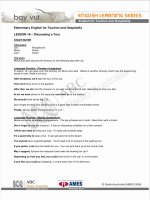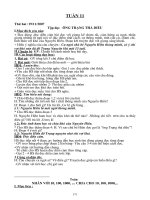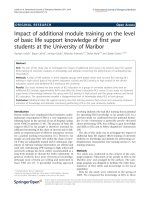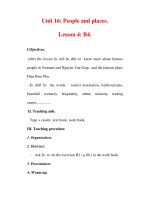4 16 visiting cape canaveral
Bạn đang xem bản rút gọn của tài liệu. Xem và tải ngay bản đầy đủ của tài liệu tại đây (2.69 MB, 10 trang )
Fascinating Facts
• On the Apollo 11 mission, astronauts had
only two different meals to choose from.
• More than six billion people live on
Earth. Fewer than five hundred have
flown into space.
• The pump on the main engine of the space
shuttle is so powerful that it can drain a
swimming pool in twenty-five seconds.
Genre
Nonfiction
Comprehension Skill
Summarize
Text Features
• Maps
• Time Line
• Captions
Scott Foresman Social Studies
ISBN 0-328-14879-2
ì<(sk$m)=beihja< +^-Ä-U-Ä-U
In this book you will read about the United
States space program. It has sent spacecraft
up to learn about other planets and even put
astronauts on the moon.
Write to It!
The United States has reached many
important goals in space exploration. What
do you think has been NASA’s biggest
success? Write a brief paragraph explaining
what you think is the most important thing
NASA has done. Support your choice with
two or three reasons.
Vocabulary
cape
satellite
space shuttle
Write your ideas on a separate sheet of paper.
space station
technology
Maps
MapQuest, Inc.
Photographs
Every effort has been made to secure permission and provide appropriate credit for photographic material.
The publisher deeply regrets any omission and pledges to correct errors called to its attention in subsequent editions.
Unless otherwise acknowledged, all photographs are the property of Scott Foresman, a division of Pearson Education.
Photo locators denoted as follows: Top (T), Center (C), Bottom (B), Left (L), Right (R), Background (Bkgd).
ISBN: 0-328-14879-2
Copyright © Pearson Education, Inc. All Rights Reserved. Printed in the
United States of America. This publication or parts thereof, may be used with appropriate
equipment to reproduce copies for classroom use only.
1 2 3 4 5 6 7 8 9 10 V0G1 14 13 12 11 10 09 08 07 06 05
Opener: ©NASA
2 Mapquest
3 ©Ralph Morse/Stringer/Getty Images
4 ©NASA
6 ©NASA
Editorial Offices: Glenview, Illinois • Parsippany, New Jersey • New York, New York
10 ©NASA
12 (C) AP/Wide World Photos,
(B) Offices:
©David E Needham,
Myers/Getty Images
Sales
Massachusetts • Duluth, Georgia • Glenview, Illinois
13 (B) Kennedy Space Center,
(T) ©Tony
Freeman/PhotoEdit
Coppell,
Texas
• Sacramento, California • Mesa, Arizona
14 ©Comstock Inc.
15 Corbis
Where is Cape Canaveral?
Just off Florida’s Atlantic coast lies Cape Canaveral.
A cape is a point of land extending out into the ocean.
Cape Canaveral is separated from mainland Florida by the
Indian River. It is also part of Florida’s Space Coast, the
world’s center of space exploration. Here you find one of
the headquarters of the National Aeronautics and Space
Administration (NASA).
Spanish explorers first visited and named Cape Canaveral in 1513.
South
Lake
CANAVERAL
NATIONAL
SEASHORE
Shuttle
Landing
Facility
Titusville
l
BCC Astronaut
Memorial
Planetarium
and Observatory
Rive
r
Visitor
Center
Merritt
Island
Lake
Poinsett
City
CAPE
CANAVERAL
AIR
Cape
STATION Canaveral
Space and
Missile Museum
Port Canaveral
Cape Canaveral
Cocoa
Key
Ban
a na
Port
St. John
JOHN F.
Titan IV Complex
KENNEDY Vehicle
Assembly
SPACE
CENTER Building
t r a c o a st a
I n d ia n In a y
Waterw
Astronaut
Hall of Fame
Shuttle Launch
Complex 39
Rockledge
Place of
interest
Lake
Cocoa
Beach
In the 1940s the United States military realized it
needed a rocket range that was far from people’s homes.
The military picked Cape Canaveral. At that time, very
few people lived on or around the cape. Workers quickly
built a new base. In 1950 the United States military sent
up its first rocket from Cape Canaveral.
ATLANTIC
OCEAN
0
Winder
The Early History
of Cape Canaveral
0
2
4 Miles
2 4 Kilometers
S
2
3
Cape Canaveral Turns to Space
Cape Canaveral grew throughout the 1950s. Then, in
1957, the Soviet Union, now Russia and other countries,
launched the world’s first satellite into orbit. A few
months later, the United States put its own satellite into
orbit from Cape Canaveral. For the next several decades,
the United States and the Soviet Union sent more than five
thousand spacecraft into orbit.
In 1958 the United States government created the
National Aeronautics and Space Administration (NASA).
NASA ran the space program from its base at Cape
Canaveral. NASA realized it needed more room almost
immediately. NASA started to look around for a new
launch base. In the end, NASA chose Merritt Island,
just north of Cape Canaveral, across the Banana River.
NASA started building a first-class spaceport, or site for
launching spacecraft. In 1965 the Kennedy Space Center
(KSC) opened its doors.
The United States launched
its first satellite, Explorer, from
Cape Canaveral in 1958.
4
5
Cape Canaveral and NASA
Today, NASA launches most of its space vehicles that
have crews from Kennedy Space Center on Merritt Island.
On nearby Cape Canaveral, NASA and the United States
Air Force launch rockets without pilots or passengers.
Millions of visitors from around the world come to the
Kennedy Space Center. Space shuttles are put together
at the Vehicle Assembly Building. The Crawler Transporter
carries the space shuttle from the Vehicle Assembly Building
and the launch pad. From the viewing area, visitors can
watch space shuttles lift off from launch pads. When it
returns to Earth, the space shuttle lands at the Shuttle
Landing Facility. After landing, space shuttles go to the
Orbiter Processing Facilities. The shuttles are inspected,
tested, and sometimes repaired there.
2
1
3
1
People come to the Visitor
Complex to learn about
space exploration.
2
The Apollo/Saturn V Center
honors the Apollo missions to
the moon.
3
6
Parts of the International
Space Station are assembled
at the International Space
Station Center.
7
Highlights of the
Space Program
Over the years, NASA has made amazing voyages
into space. Many of these have been in spacecraft with
astronauts aboard.
After years of hard work, on July 20, 1969, a
spacecraft finally landed on the moon. Neil Armstrong
took a short walk across the surface of the moon.
In 1973 NASA sent Skylab into space. Skylab was the
first space station, or a human-made structure orbiting
in space that people can live in for several months. Skylab
astronauts lived and worked aboard the space station to
learn about the space environment.
In 1981 NASA sent up the first space shuttle. Space
shuttles have wings, so they can glide back to Earth.
Space shuttles carry astronauts into space to do
experiments or visit space stations. Some shuttles also put
satellites into space.
Time Line of the Space Race
1969
1958
The United States launches
the satellite Explorer I.
1965
1959
The Soviet Union lands
Lunar 2 on the moon.
1957
1958 1959
1960
1961
1957
The Soviet Union launches
the satellite Sputnik 1.
8
On March 18 a Soviet
astronaut leaves his
spacecraft and walks
in space.
1965
On July 20 NASA’s
Apollo 11 lands
on the moon. Neil
Armstrong and
Edwin “Buzz” Aldrin
walk on the surface
of the moon.
1975
A United States spacecraft joins
together with a Soviet spacecraft. This is
the first international space flight.
1969 1970
1972
1975
1961
1970
1972
On April 12 the Soviets send Yuri
Gagarin into space. On May 5 NASA
sends Alan Shepard into space.
The Soviets
land a
spacecraft
on Venus.
The United States launches
Pioneer 10. More than a year later,
the spacecraft flies past Jupiter.
In 1983 it passes Neptune.
9
NASA Satellites
Hundreds of satellites are launched from Cape
Canaveral and the space shuttle. What do all these
satellites do? Cameras aboard satellites take pictures that
help scientists study the earth. Some images caught “red
tides” along Florida’s coast. These tides were caused by
dust from Africa’s Sahara Desert that was blown across
the Atlantic Ocean.
The space shuttle also brings astronauts to and from the
International Space Station. NASA built the space station
in the 1990s. On the space station, astronauts do many
experiments, like grow plants in space.
Hundreds of people on the ground also contribute to
the space program. At the International Space Center
astronaut practice on the tools and machines they will use
in space. This is their last stop before blasting into space.
Some parts of the International
Space Station are put together on
the ground.
10
11
Over the years NASA technology has led to many
useful inventions. Sometimes technology makes life easier.
It can also save lives.
Infrared Thermometer
Years ago NASA created a special technology
to measure the temperature of stars and planets
from Earth. Now the thermometer measures a
person’s temperature in less than two seconds.
Whale “Tailprints”
NASA scientists created special software to see
how space shuttles work. Today, scientists who
study life in the oceans use that software to
create a file for each humpback whale they
photograph. Each whale’s “tailprint” is
unique, just like your fingerprints. Using
these files, biologists can track and
identify the whales swimming in
the ocean.
Smoke Detector
NASA scientists needed to make
sure no fires started aboard
Skylab, so they invented a smoke
detector. Today, almost all homes in
the country have smoke detectors,
because they help save lives.
Infrared technology has also proved to be a big
help to Florida. Firefighters putting out blazes in large
buildings use an infrared camera set on top of a high
ladder. The pictures let firefighters see everything that
is going on in the area. Even citrus growers use this
technology. Planes carrying infrared cameras take
pictures of trees. Then computers count the trees and
identify unhealthy ones.
Breathing System
If a fire breaks out on the launch
pad, rescue workers need to get on
the job fast! So NASA started the creation
of special equipment for emergency rescue
workers. The new air pack was small,
light, and it helped cool the body. Today,
firefighters and other emergency workers can
use this kind of air pack and increase their
chances of saving lives.
13
Today, the Kennedy Space Center opens its doors to
millions of tourists. These visitors welcome the chance
to learn more about the space program, examine space
gear, and sometimes even see a spacecraft launch. Over
the years, thousands of people have settled in the towns
along the Space Coast. Researchers and scientists are
just some of the people who make the American space
program happen.
Astronauts aboard the International Space Station are
working to answer this question: Can humans live on Mars?
The Future of Space
The crew of the space shuttle
Endeavour pose together.
What does the future hold for the space age? No one
can say, but everyone hopes that the exploration will
continue.
NASA is helping other countries build spaceports.
NASA believes that in the future, more people will use
spaceflight to travel. NASA hopes that in the future
spaceports will launch spacecraft each day.
14
15
In this book you will read about the United
Glossary
States space program. It has sent spacecraft
Write to It!
cape
pointabout
of land
extending
up to alearn
other
planetsout
and even put
into the ocean
astronauts
on the moon.
satellite an object that orbits Earth or
another heavenly body
The United States has reached many
important goals in space exploration. What
do you think has been NASA’s biggest
success? Write a brief paragraph explaining
what you think is the most important thing
NASA has done. Support your choice with
two or three reasons.
space shuttle a reusable spacecraft that can
carry people and cargo
space station Vocabulary
a human-made structure
orbiting in space that
people can live in for
cape
several months
satellite
technology the use of scientific knowledge to
space shuttle
solve practical problems
space station
Write your ideas on a separate sheet of paper.
technology
Maps
MapQuest, Inc.
Photographs
Every effort has been made to secure permission and provide appropriate credit for photographic material.
The publisher deeply regrets any omission and pledges to correct errors called to its attention in subsequent editions.
Unless otherwise acknowledged, all photographs are the property of Scott Foresman, a division of Pearson Education.
Photo locators denoted as follows: Top (T), Center (C), Bottom (B), Left (L), Right (R), Background (Bkgd).
ISBN: 0-328-14879-2
Copyright © Pearson Education, Inc. All Rights Reserved. Printed in the
United States of America. This publication or parts thereof, may be used with appropriate
equipment to reproduce copies for classroom use only.
1 2 3 4 5 6 7 8 9 10 V0G1 14 13 12 11 10 09 08 07 06 05
16
Opener: ©NASA
2 Mapquest
3 ©Ralph Morse/Stringer/Getty Images
4 ©NASA
6 ©NASA
10 ©NASA
12 (C) AP/Wide World Photos, (B) ©David E Myers/Getty Images
13 (B) Kennedy Space Center, (T) ©Tony Freeman/PhotoEdit
14 ©Comstock Inc.
15 Corbis









